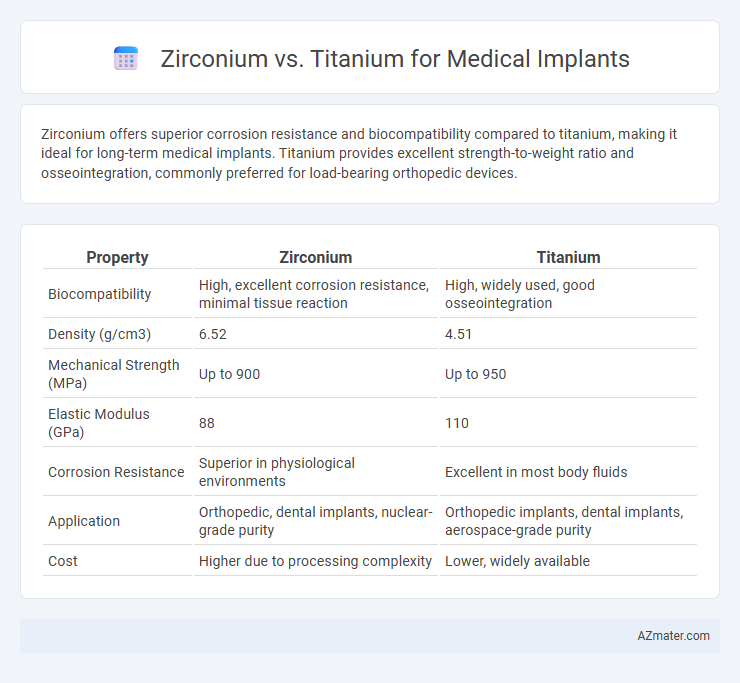Zirconium offers superior corrosion resistance and biocompatibility compared to titanium, making it ideal for long-term medical implants. Titanium provides excellent strength-to-weight ratio and osseointegration, commonly preferred for load-bearing orthopedic devices.
Table of Comparison
| Property | Zirconium | Titanium |
|---|---|---|
| Biocompatibility | High, excellent corrosion resistance, minimal tissue reaction | High, widely used, good osseointegration |
| Density (g/cm3) | 6.52 | 4.51 |
| Mechanical Strength (MPa) | Up to 900 | Up to 950 |
| Elastic Modulus (GPa) | 88 | 110 |
| Corrosion Resistance | Superior in physiological environments | Excellent in most body fluids |
| Application | Orthopedic, dental implants, nuclear-grade purity | Orthopedic implants, dental implants, aerospace-grade purity |
| Cost | Higher due to processing complexity | Lower, widely available |
Introduction to Zirconium and Titanium in Medical Implants
Zirconium and titanium are widely used materials in medical implants due to their exceptional biocompatibility and corrosion resistance. Titanium, known for its high strength-to-weight ratio and osseointegration properties, has been the standard choice in orthopedic and dental implants. Zirconium, often alloyed with niobium, offers similar mechanical strength with enhanced wear resistance and superior aesthetics due to its grayish-white color, making it increasingly popular for dental and joint replacements.
Biocompatibility: Zirconium vs Titanium
Zirconium and titanium are both highly biocompatible metals widely used in medical implants due to their excellent corrosion resistance and minimal toxicity. Zirconium offers superior resistance to corrosion in body fluids, which enhances its integration with bone tissue and reduces inflammatory responses compared to titanium. Titanium remains the gold standard for implants because of its proven long-term stability, osseointegration properties, and mechanical strength, but zirconium's increased biocompatibility is driving its growing use in dental and orthopedic applications.
Mechanical Strength and Durability Comparison
Zirconium exhibits superior corrosion resistance and biocompatibility compared to titanium, making it highly durable for medical implants subjected to prolonged bodily exposure. Titanium offers exceptional mechanical strength with a favorable strength-to-weight ratio, ensuring implants withstand significant stress without failure. Both metals provide excellent osseointegration, but zirconium's fatigue resistance often results in longer implant lifespan under cyclic loading conditions.
Corrosion Resistance in Biological Environments
Zirconium exhibits superior corrosion resistance compared to titanium in biological environments due to the formation of a dense and stable zirconium oxide (ZrO2) layer that effectively prevents metal ion release. Titanium forms a protective titanium dioxide (TiO2) film, which also provides excellent corrosion resistance but may be more susceptible to localized corrosion under aggressive conditions such as inflammation or acidic environments. The enhanced biocompatibility and corrosion resistance of zirconium make it a promising alternative for medical implants exposed to complex bodily fluids and mechanical stresses.
Osseointegration and Bone Compatibility
Zirconium and titanium are widely used materials in medical implants, with titanium renowned for its excellent osseointegration due to its stable titanium oxide layer that promotes strong bone bonding. Zirconium offers superior biocompatibility and reduced ion release, enhancing bone compatibility and minimizing inflammatory responses. Both metals support successful implant integration, but titanium remains the gold standard for its proven long-term clinical outcomes in bone integration.
Allergic Reactions and Hypersensitivity Risks
Zirconium exhibits lower allergic reaction rates and hypersensitivity risks compared to titanium, making it a preferable choice for patients with metal sensitivities. Titanium, while biocompatible and widely used, can occasionally trigger immune responses or metal allergies, particularly in susceptible individuals. Both metals offer excellent corrosion resistance, but zirconium's inert oxide layer enhances its hypoallergenic properties, reducing inflammation and implant rejection incidents.
Weight and Density Differences
Zirconium and titanium are both biocompatible metals commonly used in medical implants, with titanium having a lower density (~4.5 g/cm3) compared to zirconium (~6.5 g/cm3), making titanium significantly lighter. The reduced weight of titanium implants contributes to improved patient comfort and ease of integration, whereas zirconium's higher density offers enhanced strength and wear resistance. Weight differences impact surgical handling and post-operative recovery, with titanium preferred in applications prioritizing lightweight implants and zirconium favored for durability.
Surface Modifications and Coatings
Zirconium and titanium both undergo surface modifications and coatings to enhance their biocompatibility and corrosion resistance in medical implants, with zirconium often receiving oxide layer treatments that improve wear resistance and reduce ion release. Titanium implants benefit from surface modifications such as plasma spraying, anodization, and hydroxyapatite coatings, which promote osseointegration and antimicrobial properties. Comparing the two, zirconium's naturally formed zirconia layer provides a smoother surface that can reduce bacterial adhesion, while titanium's versatile coating options allow tailored enhancements for specific implant applications.
Applications: Orthopedic, Dental, and Cardiovascular Implants
Zirconium and titanium are prominent materials in medical implants due to their biocompatibility and mechanical properties. Zirconium is favored in dental implants for its superior corrosion resistance and aesthetic similarity to natural teeth, while titanium dominates orthopedic implants because of its strength-to-weight ratio and osseointegration capabilities. In cardiovascular implants, zirconium alloys offer enhanced wear resistance and reduced metal ion release, making both metals essential choices tailored to specific clinical applications.
Cost, Availability, and Future Prospects
Zirconium and titanium are both widely used materials for medical implants, with titanium being more cost-effective and readily available due to its established manufacturing processes and abundant reserves. Zirconium offers superior biocompatibility and corrosion resistance but comes at a higher price point and limited availability, impacting its broader adoption. Future prospects for zirconium in implants focus on surface modification technologies to enhance osseointegration, while titanium research emphasizes alloy development to improve strength and reduce costs.

Infographic: Zirconium vs Titanium for Medical implant
 azmater.com
azmater.com